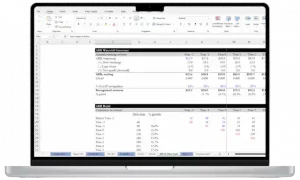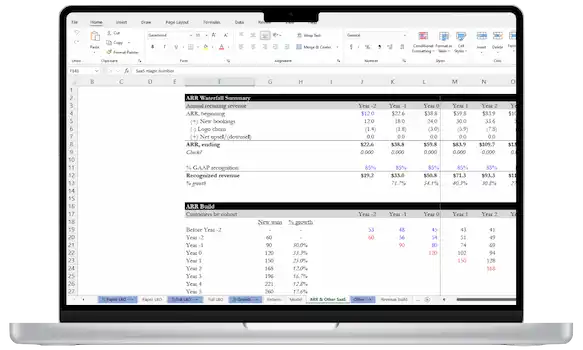Understanding financial modeling is a must for anyone who is looking to join the world of venture capital and investing. This article offers a comprehensive guide to venture capital financial modeling, covering its definition, importance, process, real-life examples, challenges, and best practices.
So whether you’re new to investing or an experienced finance professional, this guide will equip you with the knowledge to make smart investment decisions. Let’s get started!
What Is Venture Capital Financial Modeling?
Venture capital financial modeling involves the creation of a financial model to forecast the performance of a business under consideration for investment.
Just like in investment banking and other disciplines, the financial model includes details such as the company’s expenses, revenue, and growth projections. It also shows investors how their money is going to be put to work, and what the returns from the investment will be.
Venture capitalists (VCs) can then utilize the data to decide whether they should invest in a startup company or not.
Importance of Financial Modeling in Venture Capital
The importance of a financial model in venture capital depends highly on the stage and focus of the firm.
For instance, if you are a venture capitalist focusing on seed stage investments, the financial model will not be super critical. It might be a helpful input to your decision making (e.g. as a way to understand how the business works, what levers are important, and how the funding will be used). But it’s very unlikely that you’d use a financial model to actually measure your expected returns.
Meanwhile, if you’re investing in later rounds, say Series A or later, it’s likely the financial modeling will become more important in your process and your decision making. This is because the companies you are targeting for investment have more traction and more financial performance for you to analyze and base future projections off of.
Venture Capital Financial Modeling Process
There are many different forms of venture capital financial planning. However, the process typically involves forecasting the startup company’s default financial plan, expenses and revenue, and projecting the startup’s valuation over a certain amount of time.
This gives VCs the data they need to decide whether to invest money from a venture capital fund into the company. It also shows them how much they should receive in return for the money they invest.
Revenue
The revenue element of a venture capital financial model highlights the amount of money the business currently brings in. It’s considered to be the most important part of the model.
You must be very careful when creating a revenue forecast. If you over-inflate the numbers then it can put off investors and make it hard to reach the targets you set out.
Growth
Growth is another crucial part of venture capital financial models. It demonstrates the ways in which the company plans to grow its revenue over time.
VCs are looking to invest venture capital funds in companies with solid growth plans. If there isn’t a clear plan for growth, then the initial investment won’t be worth it.
Expenses
This section of the model shows VCs a company’s variable and fixed costs, and all one-time expenses. This is important information for VCs as expenses can reduce profits and also have an effect on free cash flows.
Even if the business’s performance is above expectations, high expenses can prevent it from being a sustainable company.
Valuation
The valuation of a company determines the price assigned to a business at the stage it’s currently in. Startup valuation can greatly impact the amount of money a startup is able to raise.
There are a number of methods used for calculating this valuation. Each method comes with different pros and cons.
- The earnings multiple: This method multiplies the earnings of a company by a number. Depending on the specific industry, this number varies highly. The upside of this method is that the company’s revenue and expenses are both taken into account.
- The revenue multiple: This method multiplies the revenue of the company by a certain number. Again, the number varies but can be anywhere from 2 to 100x, depending on the company and its momentum. The downside of this method is that the company’s expenses and future potential aren’t taken into account.
- The discounted cash flow method (DCF): This is a much more complicated method than the two above. It calculates how much the company’s future potential will be worth in today’s money.
Financial Modeling Example
The financial models you build in venture capital will depend highly on the situation (e.g. the company, the industry, and time you have) and also the stage.
It’s unlikely you’ll build private equity style models with tons of detail. Instead, you’ll usually build a compact but useful model to understand the business better.
To give you a base “framework” for modeling in venture capital, it is useful to think about what’s known as the Venture Capital Method. This was developed by Bill Sahlman in 1987.
This is FAR from an industry standard. In fact, if you ask VCs about this, many will not have heard of it by name. However, even if the name doesn’t register for them, the general process / steps is one that largely pervades all venture capital modeling exercises.
The Venture Capital Method has six steps:
- Estimate how much investment will be needed
- Forecast startup financials
- Determine the timing of the exit (M&A, IPO, etc.)
- Calculate multiple at exit
- Discount to present value (PV) at the desired rate of return
- Determine valuation and desired ownership stake
Let’s take a look at an example of using this method to create a financial model for a company called ‘TechCo’.
- Estimate how much investment will be needed:
TechCo estimates it needs a total investment of $5 million to develop and launch its software product. This includes product development, marketing, and operational expenses. - Forecast startup financials:
Revenue: Based on market research and projections, TechCo estimates its revenue to be $1 million in Year 1, $3 million in Year 2, and $5 million in Year 3.
Operating expenses: TechCo estimates its operating expenses to be $500,000 in Year 1, $1 million in Year 2, and $1.5 million in Year 3.
Net income: Calculate the net income by subtracting the operating expenses from the revenue. - Determining the timing of exit:
TechCo plans to exit through a potential acquisition by a larger tech company within 5 years. - Calculate multiple at exit:
Conduct industry research and identify comparable companies that have been acquired recently. Determine the average acquisition multiple (e.g. 4x revenue) based on these comparable transactions. - Discount to present value (PV) at the desired rate of return:
Determine the desired rate of return for the venture capital investors. Let’s say it’s 30%. Discount the projected cash flows from the company’s financials to their present value using the desired rate of return. - Determine valuation and desired ownership stake:
Use a discounted cash flow (DCF) analysis to determine the valuation of TechCo at the time of exit.
Let’s say the DCF analysis yields a valuation of $20 million for TechCo at the time of exit. If the investors want a 20% ownership stake the desired investment would be $4 million (20% of $20 million).
In this example, TechCo would look for a $4 million investment in return for a 20% ownership stake. This financial model takes into account the investment needed, projected financials, timing of exit, industry multiples, desired rate of return, and valuation to arrive at these figures.
However, this is just a fairly simple example. Venture capital financial models can be much more complex than this. They may also include other factors like market risks, sensitivity analysis, and market approaches.

- 66 lessons
- 12+ video hours
- Excels & templates
Challenges of Developing Financial Models for Venture Capital
The process of developing a financial model for venture capital can be fairly arduous. There are certain challenges that you need to be aware of.
Extensive modeling required
The field of venture capital is a complex one and a large amount of modeling is needed to assess the financial performance of a company.
As there are so many factors to consider, multiple scenarios often need to be created so that the various components can be covered. This absorbs a lot of time and resources which makes venture capital modeling pretty difficult.
Data limitations
When building a model for venture capital, there are often limited sources from where you can gather data. It takes a lot of effort to find reliable financial information about companies and to gather comparable data from past investments.
You may also have to adjust the data you gather for currency differences. This can make it tricky for a modeler to produce information that’s reliable and accurate.
Creating adaptable models
Venture capital investing is a long-term process. This means that any models you create must be adaptable and be able to accommodate different uses.
For example, new market conditions must be accommodated. This could include things like changes in industry regulations or trends. You need to build flexibility into your models so that they can be quickly adjusted.
Venture Capital Financial Modeling Best Practices
So, I’ve covered the challenges of this type of modeling. But there are plenty of things you can do to make your models as successful as possible.
Firstly, you need to make sure that your models are easily understandable and usable. This means that the investors can easily and effectively use it. Plus, it should be up-to-date and accurate. It should reference key metrics from the company’s business model.
Pay close attention to detail
As a financial modeler, being detail-oriented is vital. Even small expenses can quickly build up so you need to track and forecast them accurately.
Financial literacy
Being a financial expert isn’t essential to create a model but you do need to show that you have a good level of financial literacy. You should be able to effectively explain the numbers that are included in your model.
Plus, you need to be able to demonstrate the ways these numbers affect the financial health of the company.
Contingency planning
Investors will expect you to prepare contingency plans for your model. These serve as backups when there are things like unexpected expenses or revenue shortfalls.
Keep assumptions realistic
Make sure that you keep your assumptions realistic and bear seasonality, market trends, and customer behavior in mind. Your model will be much more accurate if your assumptions are realistic.
Show investors how their money will be used
You need to clearly demonstrate how the invested capital is going to be used. So, you must provide a detailed plan for the investors to examine.
Demonstrate that there’s a market opportunity
Investors need to see that there’s a market opportunity for the company. There must be a demand for the company’s products or services and you need to be able to clearly show this.
Outline the company’s key performance indicators (KPIs)
The investors must be shown what the KPIs are for the company. These are crucial for measuring and tracking the company’s progress. They allow investors to see that the business is on course to meet its goals.
FAQs
What expenses should be included in a venture capital financial model?
There are several expenses that should be included in your model:
- Personnel expenses: This includes salaries and benefits for founders, executives, employees, and contractors. Plus, payroll taxes and other related expenses.
- Marketing and sales expenses: This includes marketing campaigns and materials, advertising and promotional activities, sales team salaries and commissions, and trade show participation fees.
- Research and development expenses: This includes costs associated with product development, design, and engineering.
How frequently should a venture capital financial model be updated?
How frequently you need to update your model depends on numerous factors. This includes the stage of the startup, the rate of growth, and the availability of new information.
Generally, you should strike a balance between updating it frequently enough to reflect material changes and avoiding excessive updates that hinder operational focus.
What tools are useful for venture capital financial modeling?
The most commonly used tools for venture capital financial modeling are Excel or Google Sheets and financial modeling platforms like QuickMVP, ProjectionHub, and LivePlan.
Conclusion
Continuous learning is crucial for success in this dynamic field. If you’re looking for more in-depth lessons and discussion on growth equity investing, don’t miss out my Growth Equity Interview Guide.
This self-paced online course is tailored for professionals like you who want to maximize their chances of securing a role in finance.
Check it out and start learning today!


 Break Into Growth Equity
Break Into Growth Equity

